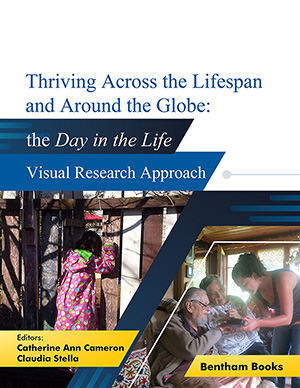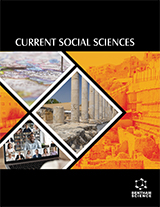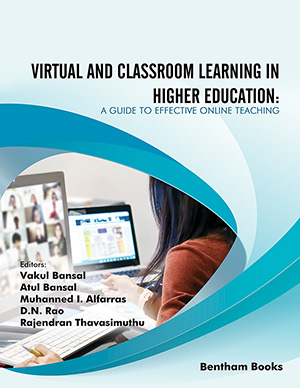Development of the Day in the Life Approach for Studying Participants Across the Lifespan and Around the Globe
Page: 1-5 (5)
Author: Catherine Ann Cameron*
DOI: 10.2174/9781681088808121010004
PDF Price: $15
Abstract
Our visual approach films one Day in the Life (DITL) of thriving participants at different periods of development over the lifespan (Gillen & Cameron, 2010; Italian translation, 2015; Brazilian adaptation, 2018) and in diverse locations around the globe. We have visual DITL records for seven thriving toddlers (30-month-olds). We have studied eleven children in successful transition to school (five- to seven-year-olds). We have filmed and reported on the Days of eight resilient migrant adolescents (13- to 15- year-olds); and six older adults (over 80-years-of-age) who are living independently at home). The films are supported by individual interviews with participants and members of their families and follow-through exchanges with participants when and wherever possible.
Brief History of the Changing Trends in Audio- Visual and Visual Research
Page: 6-18 (13)
Author: Nora Didkowsky*
DOI: 10.2174/9781681088808121010005
PDF Price: $15
Abstract
This chapter outlines some of the key historical and epistemological shifts that have affected how visual and audio-visual methods have been understood and used in the social sciences. It details the technological advances and broader theoretical transitions that have enabled new opportunities for working with teams across disciplinary, geographic, and cultural boundaries. It uses the Day in the Life audiovisual, quasi-ecological methodologies as an exemplar where possible, of a more collaborative and participatory research design that uses visuals and reflection to foster reciprocity between researchers and participants, minimize power barriers and produce new knowledge, while amplifying the authenticity of the research findings.
Importance of Video-Centred Ethnography in a Day in the Life Project: A Case of Beavers and Citizenship
Page: 19-26 (8)
Author: Julia Gillen* and Catherine Ann Cameron
DOI: 10.2174/9781681088808121010006
PDF Price: $15
Abstract
This chapter describes how the use of visual methods in the Day in the Life (DITL) programme enables investigation of the multimodal, mobile, participants from multiple perspectives. At the heart of the approach is the videoing of a whole day and then later bringing a compilation into discussion with participants, itself also a site for further data generation. The DITL approach has been deployed in various projects in diverse communities around the globe. The project considered here as an exemplar, worked with 10 thriving young children in transition to school in four countries. The theme of “beavers as symbols of Canada” emerged in one young girl’s learning about citizenship during a kindergarten whole class reading lesson in the morning, and subsequently her discussions with her multi-generational family in the afternoon. We explain how our explorations with visual data enable us to investigate the coconstruction of knowledge and connections made across the events.
Behind the Scene: Reflections on Researchers' Experiences While Capturing Audio-Visual Data during a Day in the Life
Page: 27-37 (11)
Author: Nora Didkowsky* and Cindy Lau
DOI: 10.2174/9781681088808121010007
PDF Price: $15
Abstract
In this chapter, we reflect on the making of a Day in the Life (DITL), that is, the audio-visual methodologies used to examine resilience processes for youth in transition in diverse contexts (Cameron, Theron, Tapanya, Li, Lau, Liebenberg & Ungar, 2013). We explore the experience of capturing visual data in quasi-ecological settings from the researcher's perspective. We give an account of how our training as DITL researchers, the equipment we utilized, the social and physical environments in which the filming occurred, decisions about sound, lighting and compositionality, unanticipated ethical quandaries in the field, and participants' reactions to the camera, all played essential roles in the visual data co-created with participants.
Touch as a Communicative and Exploratory Medium
Page: 38-47 (10)
Author: Nuala Hancock and Roger Hancock*
DOI: 10.2174/9781681088808121010008
PDF Price: $15
Abstract
This chapter provides an examination of the specific actions of two people immersed in their respective family contexts in Lithuania and Turkey. Both were filmed continuously for one day in their lives thus providing approximately eight hours of video data for each person. The chapter selects very small segments of the total footage available to choose exact and fleeting visual moments of life for close analysis. Video enables such a fine-grain selection because it captures 25 frames per second so even 20 seconds of film can be imbued with meaning and interpretation. The first study comes from Jonas, an older Lithuanian adult, who shares with his grandchildren some of the moves and rules of chess, and then engages them in the processes of playing his accordion. The second study arises from Selin, a 24-month-old Turkish child, as she examines the moving arm of a toy monkey and the way in which it impacts on a small bell, and then explores the nature of a necklace with her hands, face, and mouth. In seeking explanations of the events observed, the chapter draws on theorists from the fields of phenomenology and material culture, for instance, Pallasmaa (2009), Stewart (2005, 1999), Ellsworth (2005), Merleau-Ponty (1945; 2020, Tilley (2004), and Casey (1993).
Family, School, and Transition: Importance of Family Support in this Process
Page: 48-55 (8)
Author: Roseli Fernandes Caldas* and Bruno Bertoni Giusti Roque
DOI: 10.2174/9781681088808121010009
PDF Price: $15
Abstract
Several studies have revealed contextual tensions in the lives of children and young people going through cultural transitions. However, despite the necessary adaptations, many migrant children have had a good performance in their schooling processes. Considering Bronfenbrenner’s ecological framework and bio-psychosocial approach and using the “Day in the Life” approach, the aim of this chapter is to identify and analyse the experience of cultural transition and acculturation of an eight-year-old boy who, having moved from Bahia with his parents and sister, currently lives in the city of São Paulo. Caio is considered to be a successful case in this process of cultural transition, given his adaptation to the school and community environments, and his good performance in developing literacy and in the socialisation process. The research indicated mutual influence of events experienced at school and with his family, especially through imitation, resulting in a positive cultural interlocution between these two ecological contexts. It was observed that the child felt great satisfaction when presented with opportunities to apply what he learned at school in his family’s everyday life, during play, with electronic games, and in the family context. The study also examined the importance of the family as an ecosystem which preserves the previous culture, offering support and security for a successful introduction and appropriation of the new culture, allowing him to overcome challenges and resulting in the integration of the inherited and of the new ecosystems.
Home Work: Bridging the Worlds of Home and School
Page: 56-62 (7)
Author: Anne Kathryn Hunt*, Catherine Ann Cameron and Serena Jenkins
DOI: 10.2174/9781681088808121010010
PDF Price: $15
Abstract
The ways in which the cultures of school and home affect children's learning have been studied intensively, often in comparison, one with the other. Moll et al. (1992), for example, described the work educators and families do to support that learning in both contexts. Their work is primarily with immigrant families, where the contexts between home and school can be dramatically different, but we believe that all children face challenges when moving between those cultures. Attending to the work they must do to bridge the two worlds, however, can be difficult to document. Our Day In the Life approach affords the opportunity actually to be with the child during the course of one entire waking day, and to monitor the work they do as they move from home to school and back home again, allowing us to observe, document and reflect upon the manner in which children navigate their home-school work.
Benefits of Cultural Transitions to Educational Success
Page: 63-71 (9)
Author: Roseli Fernandes Caldas*, Guilherme Silveira Caltabellotta and Lara Di Mauro Pedro
DOI: 10.2174/9781681088808121010011
PDF Price: $15
Abstract
To children starting their schooling process, the insertion into another cultural context can often be a critical period in academic development. Based on Bronfenbrenner’s ecological framework and biopsychosocial approach, and using the “Day in the Life” approach, this chapter presents the experience of Vitória, a six/sevenyear- old girl born in Rio Grande do Sul, a state in the south of Brazil, now living with her mother in the city of São Paulo. The constant trips mother and daughter make to their home state allow contact with grandparents and cousins, along with the family’s original culture, favouring the maintenance of the southern influence in her day-to-day life. This can be observed in her vocabulary, in some of her activities, and social interactions. Vitória displayed successful integration, preserving elements from her original culture while demonstrating excellent adaptation to the new routines in São Paulo. The interconnections – among family, teachers, and school – greatly contributed to the child’s flourishing transition, enabling a secure intercultural identity, combining values of both cultural contexts effectively. In order to live inside and in-between two cultural contexts, assimilating traditional values and beliefs inherited from the family is necessary, while also assimilating new cultural values and beliefs of the society and specifically the newly encountered school system. The intercultural success of this child is observable in how she integrates two cultures with confidence and admiration from her parents and teachers, dealing with the values of both social groups in a symbiotic and non-competitive way.
Success Among Peers: Social Skills in Adaptive Process
Page: 72-81 (10)
Author: Susete Figueiredo Bacchereti*, Caroline Leão de Morais and Tainner Vinicius Pinheiro de Almeida
DOI: 10.2174/9781681088808121010012
PDF Price: $15
Abstract
Júlio is a six-year-old boy who lives in the southern area of the city of São Paulo with his parents and younger sister. Compared with many children in his age group (five- to six-years-old), he has already lived in five different Brazilian states. This has enabled him to be adaptable and to socialise easily. In his family environment, Júlio spends the morning and evening with his mother and younger sister, and sees his father when he arrives home at dinnertime. There is a closeness in their relationships, and there is room for childhood learning, for conversation, and for play among the family members throughout the day. At school, Júlio has a group of special friends, but he also interacts with many other classmates during activities in the classroom and during breaktime. We observed that, due to his sociable nature, Júlio appears loved by those who surround him. He exhibits attentiveness during his formal education hours, enabled by his school's teaching methods. Júlio is invited to choose which subjects and at what moment in the day he prefers to study. He commits to a chosen task in an organised way, as well as focusing, asking questions, and interacting with classmates. Additionally, soccer is very important to him and his success, not only as a fun activity but also offering him a time to take responsibility as a player. This game permeates many of his interactions with others.
Learning Through Imitation in Daily-Life at Home and School
Page: 82-95 (14)
Author: Monica Toselli, Giuliana Pinto* and Catherine Ann Cameron
DOI: 10.2174/9781681088808121010013
PDF Price: $15
Abstract
Imitation plays a pivotal cognitive and social role during human development and has been widely studied by developmental psychologists. However, researchers rarely follow children as they imitate in their natural social spaces, across different interactions over time, so core questions as to the quantity and quality of imitative behaviours in childhood have yet to be answered. This paper, adopting a quasi-ecological approach, examines the imitation enacted with two first-year primaryschool pupils (one male and one female) in the flow of their everyday interactions with family and schoolmates. The study is part of a broader interdisciplinary research programme, investigating the transition-to-school of children in diverse communities around the globe. Two Italian children were video-recorded during one Day in their Lives, at home and school. Our analysis draws upon this filmed naturalistic corpus. Our operational definition of imitation is: A behaviour that immediately replicates a modelled behaviour. We developed a data-driven interpretational grid for the different acts of imitation documented. The grid categorizes patterns of imitative acts, emerging over time, along six polar dimensions: From unintentional to intentional; spontaneous to requested; one-sided to reciprocal; exact to varied; already acquired to newly learned; and permitted to prohibited. Home and school contexts offered varied affordances for imitation and allowed documentation of how prevalent, multifaceted, and powerful imitation is across contexts and companions of primary-school children. Documentation of imitative behaviours in real-time and in ecological context sheds light on the import of imitation and its associated theoretical conceptualizations.
Musicality and Intergenerational Support for Thriving Children in Transition: Estela’s Case Study
Page: 96-104 (9)
Author: Claudia Stella* and Juliana Muniz Nazima
DOI: 10.2174/9781681088808121010014
PDF Price: $15
Abstract
A day in Estela’s life is similar to that of many six-year-old girls, since she spends the day with her grandmother, except for the period she is at school. However, she experiences a relation that is the opposite of the expected: The granddaughter has the function of caring for her visually impaired grandmother, helping her move around and eat. In-between challenges, Estela’s day-to-day life is permeated by relaxed and good-tempered exchanges, with games and rhymes her grandmother recollects from her childhood in the state of Bahia, thus teaching her granddaughter, who was born in São Paulo. It is through music that the grandmother shares her experiences and her history, enabling affective bonds to be built between them and affording intergenerational exchange and support. This relationship lets the girl assimilate, in a positive way and from an early age, the difficult life her grandmother had in the countryside of Bahia and still experiences because of her visual impairment. Through music, which fills their shared life with lightness, the girl develops the feelings of empathy and solidarity. Additionally, Estela applies the values she learns from her grandmother in her everyday life, and they are reflected in her transactions with other people, both at home and at school.
Successful Integration of New and Heritage Cultures
Page: 105-111 (7)
Author: Susete Figueiredo Bacchereti*, Fernanda Baltieri Bergantin and Thais La Rosa
DOI: 10.2174/9781681088808121010015
PDF Price: $15
Abstract
Cultural Community is a fundamental analysis category that encompasses children, their families, teachers, and all the additional contexts in which children are inserted. In this category, we analyse the daily routine of Omar as he interacts with others in his family, school, and new Brazilian community. We consider the implicit and explicit family values that appear in social and material relations between parents and children; the ways children model such interactions; and, as a result, how these interactions seem to affect the family notion regarding what is a successful child. Bearing this perspective in mind, we observe that the community cultural values manifest and shape the child’s interactions with, and consequently transform, the environment in a dialectic process. Omar is interculturally successful, as he manages to integrate aspects of his original Arabic culture and his current Brazilian multicultural context with confidence, admiration, and aid from his parents, teacher, and classmates. Omar represents a secure intercultural identity – one where the values and customs of different social groups interact in his life in a symbiotic and non-competitive way.
“When you Laugh, the World is Again Beautiful”: Use of Humour by Thriving Older Adults
Page: 112-123 (12)
Author: Nora Didkowsky*, E. Leslie Cameron and Catherine Ann Cameron
DOI: 10.2174/9781681088808121010016
PDF Price: $15
Abstract
While applying our audiovisual approach to capture a Day in the Life (DITL) of a thriving older-adult couple aged 87 and 97 years in Switzerland, we were struck by their ubiquitous and deliberate use of humour. We identified the types of humour used and the ways in which their humorous interactions served multiple socio-emotional, cognitive, physical, and linguistic functions that appear to support thriving. The older adults' use of humour enabled them to: Deal with current daily stressors and navigate complex psychosocial and physical transitions in the present; revisit and cope with traumatic experiences from the past; and impart valuable life lessons that prepare them, and others, for future challenges. The more that older adults can exploit their psychosocial and other strengths to master their landscapes, the more successful can be their negotiation of older adulthood.
Spirituality as Support for Thriving Elderly People at an Advanced Age: Ana’s Case Study
Page: 124-131 (8)
Author: Claudia Stella* and Letícia dos Santos Gouveia
DOI: 10.2174/9781681088808121010017
PDF Price: $15
Abstract
This chapter discusses the importance of spirituality in the everyday life of a long-lived elderly woman. Thriving ageing consists of the ability to react creatively in the face of changes, by reframing identities, friendships, and family relationships. Furthermore, it involves being active in the community one is a part of, having autonomy and being capable of making one’s own choices, thus socially integrated and happy. Ana is an 88-year-old woman who lives by herself, works, drives a car, and assists numerous people through the social work she manages. A faithful Christian, Ana starts her day with prayers that prepare her for the various activities that await her. According to Erikson (1998), the psychosocial development of the ego continues through life, and, during the process of ageing, one must search for basic forces that emerged in previous stages of development in order to integrate one’s subjectivity with living life with a sense of meaning and purpose. In Ana’s case, in her environment and in her day-to-day life, spirituality (and hope) is the force that moves and integrates her actions. Hope appears as a resource that allows Ana to have an autonomous, thriving life that is filled with a sense of purpose, despite the risks and health vulnerabilities inherent in advanced age. Supported by studies about resilience as an ecological base, this chapter aims to provide a conceptual framework to investigate the personal and contextual factors involved in older, independent adults who thrive physically and spiritually.
Day in the Life Approach: History and Future Perspectives
Page: 132-136 (5)
Author: Catherine Ann Cameron* and Vanessa Figueiredo
DOI: 10.2174/9781681088808121010018
PDF Price: $15
Introduction
Thriving Across the Lifespan and Around the Globe: Day in the Life Visual Research Approach is the result of several decades of international, pan-disciplinary research-team collaborations using quasi-ecological visual methodologies to investigate the psychosocial development of children in diverse communities. The initial studies highlighted in this work involved filming a ‘Day in the Life’ of toddlers and primary school children, their families, and schools in diverse communities in Asia, South and North America, and Europe. Filmed in their homes and communities for an entire day, the youngest participants were commonly seen to be thriving in diverse psychosocial domains, such as in their security strivings, emergent literacy and graphic representations, and musicality. Research shows that the nature of a child's development can vary in as many ways as there are diverse contexts. Thriving in the transition from home to primary school is a second developmental milestone investigated in the research. The book serves as an account of the lived experiences of thriving children,among their families, their schools and their communities. The contents give an invaluable insight into the psychology of early childhood while giving the reader an opportunity to understand the resilience of mobile early teenagers as well as independent older adults. The contributions in the book also provide an additional layer to our understanding of visual ethnography by covering such phenomena as agency and communitarianism, spirituality, and the place of humour in the context of challenges encountered across the lifespan. Through presenting quasi-ecological experimental approaches, this reference enhances the reader’s insight into the texture and nature of thriving in situ, in natural contexts.













